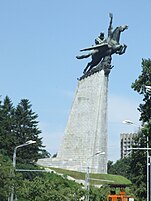How Can We Help?
There are many tourist attractions in Pyongyang, the capital of North Korea. Many are unique as remnants of communist iconography and monumentalist and brutalist architecture.[1] Tourists are not allowed to move freely and the authorities control which sights visitors can access.[2]
List
- 18 September Nursery[3]
- Academy of Koryo Medicine[4]
- Althletics Gymnasium[4]
- April 25 House of Culture[4]
- Arch of Triumph[5]
- Basketball Gymnasium[4]
- Central Botanical Gardens
- Central Youth Hall[4]
- Changgwang Health Complex[5]
- Chilsongmun[4]
- Chollima Statue[5]
- Chongnyu Restaurant[4]
- Combat Sports Gymnasium[4]
- East Pyongyang Grand Theatre[4]
- East Pyongyang No. 1 Middle School[5]
- Grand People's Study House[5]
- Handball Gymnasium[4]
- Indoor Swimming Pool Complex[4]
- International Cinema Hall[4]
- Juche Tower[5]
- Kaeson Youth Park[5]
- Kang Ban-sok Advanced Middle School[5]
- Kim Chaek University of Technology[4]
- Kim Hyong Jik University of Education[5]
- Kim Il-sung Square[5]
- Kim Il-sung Stadium[4]
- Kim Il-sung University[5]
- Kim Song-ju Elementary School[5]
- Kim Won-gyun University of Music[4]
- Kimilsungia and Kimjongilia Exhibition Hall[5]
- Korea Central Zoo[5]
- Korea Stamp Exhibition Hall[5]
- Korea Stamp Museum[6]
- Korean Art Gallery[4]
- Korean Central History Museum[4]
- Korean People's Army Circus[5]
- Korean People's Army Military Hardware Museum[4]
- Korean Revolution Museum[4]
- Kumrung Leisure Complex[5]
- Kumsusan Palace of the Sun[7]
- Kwangbopsa[4]
- Mangyongdae Children's Palace[5]
- Mangyongdae Funfair[4]
- Mangyongdae Wading Pool[4]
- Mangyongdae[8]
- Mansu Hill Grand Monument[5]
- Mansudae Art Studio[5]
- Mansudae Art Theatre[4]
- Mausoleum of Tangun[5]
- Meari Shooting Range[5]
- Mirae Scientists Street[5]
- Mirim Riding Club[5]
- Monument to Party Founding[5]
- Moranbong Park[5]
- Moranbong Theatre[5]
- Munsu Water Park[5]
- Okryu Children's Hospital[5]
- Okryu-gwan[4]
- Party Founding Museum[5]
- People's Palace of Culture[5]
- People's Theatre[4]
- Pothonggang Circus Theatre[4]
- Potongmun[4]
- Pyongyang Bell[4]
- Pyongyang Circus[4]
- Pyongyang Embroidery Institute[5]
- Pyongyang Gold Lane[4]
- Pyongyang Grand Theatre[4]
- Pyongyang Indoor Stadium[4]
- Pyongyang Informatics Centre[5]
- Pyongyang International Football School[5]
- Pyongyang International House of Culture[4]
- Pyongyang Maternity Hospital[5]
- Pyongyang Metro[9]
- Pyongyang Ostrich Farm[5]
- Pyongyang Peoples Outdoor Ice Rink[5]
- Pyongyang Skatepark[5]
- Pyongyang Students and Children's Palace[4]
- Railway Revolution Museum[5]
- Revolutionary Martyrs' Cemetery[5]
- Rungra People's Pleasure Ground[5]
- Rungra Waterpark[5]
- Rungrado 1st of May Stadium[4]
- Ryongak Mountain[5]
- Ryongwang Pavilion[4]
- Sosan Stadium[4]
- State Gift Hall[5]
- Table-Tennis Gymnasium[4]
- Taedongmun[4]
- Taekwon-Do Hall[4]
- Taesong Fortress[4]
- Taesongsan Pleasure Ground[4]
- Three Revolutions Exhibition[4]
- Tomb of King Tongmyŏng[10]
- Ulmil Pavilion[4]
- USS Pueblo (AGER-2)[11]
- Victorious War Museum[12]
- Volleyball Gymnasium[4]
- Weightlifting Gymnasium[4]
- Wrestling Gymnasium[4]
See also
- List of amusement parks in North Korea
- List of football stadiums in North Korea
- List of hotels in North Korea
- List of museums in North Korea
- List of theatres in North Korea
- Revolutionary Sites
- Tourism in North Korea
References
- ^ Iverson, Shepherd (2013). One Korea: A Proposal for Peace. Jefferson: McFarland. p. 140. ISBN 978-1-4766-0615-6.
- ^ Albu & Cîmpean 2017, p. 76.
- ^ Hunter, Helen-Louise (1999). Kim Il-song's North Korea. Westport: Greenwood Publishing Group. pp. 122–123. ISBN 978-0-275-96296-8.
- ^ a b c d e f g h i j k l m n o p q r s t u v w x y z aa ab ac ad ae af ag ah ai aj ak al am an ao ap aq ar as at au "Tourist Attractions: Pyongyang". Naenara. Retrieved 15 September 2018.
- ^ a b c d e f g h i j k l m n o p q r s t u v w x y z aa ab ac ad ae af ag ah ai aj ak al am an ao ap aq ar "Pyongyang Attractions". Tongil Tours. Archived from the original on 9 September 2018. Retrieved 8 September 2018.
- ^ Kim Son Myong (2020). "Korea Today" (PDF). KCNA Watch. p. 40.
- ^ Tudor, Daniel (2014). A Geek in Korea: Discovering Asia's New Kingdom of Cool. Tokyo: Tuttle Publishing. p. 486. ISBN 978-1-4629-1407-4.
- ^ Corfield, Justin (2014). "Kim Il Sung". Historical Dictionary of Pyongyang. London: Anthem Press. p. 79. ISBN 978-1-78308-341-1.
- ^ Hoare, James (2012). Korea - Culture Smart!: The Essential Guide to Customs & Culture. London: Kuperard. p. 105. ISBN 978-1-85733-670-2.
- ^ Lankov, Andrei (2009). North of the DMZ: Essays on Daily Life in North Korea. Jefferson: McFarland. p. 45. ISBN 978-0-7864-5141-8.
- ^ Cheevers, Jack (2013). Act of War: Lyndon Johnson, North Korea, and the Capture of the Spy Ship Pueblo. New York: Penguin Publishing Group. p. 250. ISBN 978-1-101-63864-4.
- ^ Kim Suk-Young (2014). DMZ Crossing: Performing Emotional Citizenship Along the Korean Border. New York: Columbia University Press. p. 124. ISBN 978-0-231-53726-1.
Works cited
- Albu, Ruxandra-Gabriela; Cîmpean, Radu (2017). "Opinions on the Main Elements to Be Considered in Potential Assessment Models in Tourism" (PDF). Bulletin of the Transilvania University of Braşov. Series V: Economic Sciences. 10 (1). ISSN 2065-2194. Archived from the original (PDF) on 21 April 2018. Retrieved 8 September 2018.
External links
 Pyongyang travel guide from Wikivoyage
Pyongyang travel guide from Wikivoyage






Recent Comments